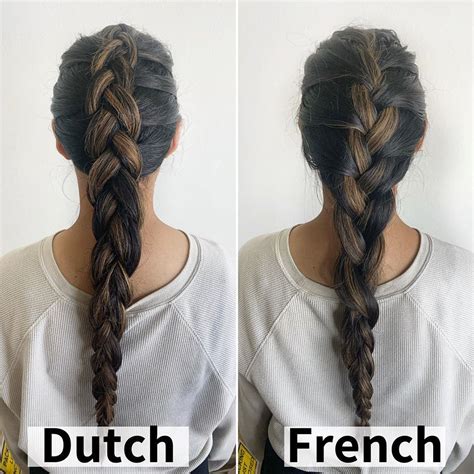Introduction
Braiding is an ancient technique used to style and manage hair. Two popular braiding styles are French braids and Dutch braids, which have distinct characteristics and applications. This article delves into a comprehensive comparison between these two braiding techniques, exploring their similarities, differences, pros, cons, and use cases.

Similarities
- Three-strand foundation: Both French and Dutch braids are based on the three-strand braiding technique, where three sections of hair are interwoven.
- Direction of weaving: In both styles, the strands are woven in an alternating over-under motion.
- Versatile: Both French and Dutch braids can be styled in different variations, such as loose braids, tight braids, and braids with accessories.
Differences
Visual Appeal:
- French braid: Creates a raised, elevated look by weaving strands over one another, resulting in a more prominent braid.
- Dutch braid: Results in an inverted, recessed look by weaving strands under one another, creating a flatter braid.
Weaving Technique:
- French braid: New strands of hair are incorporated into the braid as it progresses downward.
- Dutch braid: New strands of hair are added at the beginning of each weaving motion, creating a more secure and tight braid.
Tightness:
- French braid: Typically loosens over time due to the incorporation of new strands.
- Dutch braid: Remains tighter due to the secure weaving technique and the lack of new strands added.
Pros and Cons
French Braid Pros:
* Creates volume and height
* Flattering on all hair types
* Versatile and easy to style
* Ideal for casual and formal occasions
French Braid Cons:
* Can loosen over time
* May not hold well on shorter hair
* Can be difficult to master the technique
Dutch Braid Pros:
* Secure and tight hold
* Stays in place for longer periods
* Creates a unique and eye-catching look
* Suitable for athletic activities
Dutch Braid Cons:
* Can flatten hair
* May not be as versatile as French braids
* Can be more challenging to learn
Use Cases
French braid:
* Everyday wear
* Formal events
* Wedding hairstyles
* Creating volume and height
Dutch braid:
* Sports and athletic activities
* Endurance runs
* Outdoor adventures
* Holding back long hair
Tables for Comparison
Table 1: Visual Appeal Comparison
| Feature | French Braid | Dutch Braid |
|---|---|---|
| Appearance | Elevated | Recessed |
| Weaving | Over-under | Under-under |
Table 2: Weaving Technique Comparison
| Feature | French Braid | Dutch Braid |
|---|---|---|
| New hair addition | As it progresses downward | At the beginning of each motion |
| Tightness | Typically looser | Remains tighter |
Table 3: Pros and Cons Comparison
| Feature | French Braid | Dutch Braid |
|---|---|---|
| Pros | Volume, versatility | Secure hold, unique look |
| Cons | Can loosen, not suited for short hair | Flattens hair, challenging to learn |
Table 4: Use Cases Comparison
| Activity | French Braid | Dutch Braid |
|---|---|---|
| Casual wear | Yes | Yes |
| Formal events | Yes | Yes |
| Sports | No | Yes |
| Endurance runs | No | Yes |
FAQs
- Which braid is more secure? Dutch braids are more secure due to their tight weaving technique.
- Which braid is better for volume? French braids create more volume and height.
- Can I braid my own hair? With practice, anyone can learn to braid their own hair.
- What is the fastest type of braid? French braids are generally faster to braid than Dutch braids.
- Which braid lasts longer? Dutch braids typically last longer than French braids due to their tighter hold.
- Can I braid wet hair? Braiding wet hair is not recommended as it can damage the hair.
- What is the best hair type for braiding? All hair types can be braided, but thicker hair holds braids better.
- How often should I braid my hair? Excessive braiding can damage hair, so it is best to braid in moderation.
Conclusion
French braids and Dutch braids offer distinct styles and applications. French braids create volume and elevation, while Dutch braids provide a secure and unique look. Both braids have their own pros and cons, and the best choice depends on the desired outcome and hair type. By understanding the differences and similarities between these two braiding techniques, you can enhance your hair styling skills and create stunning looks for any occasion.
